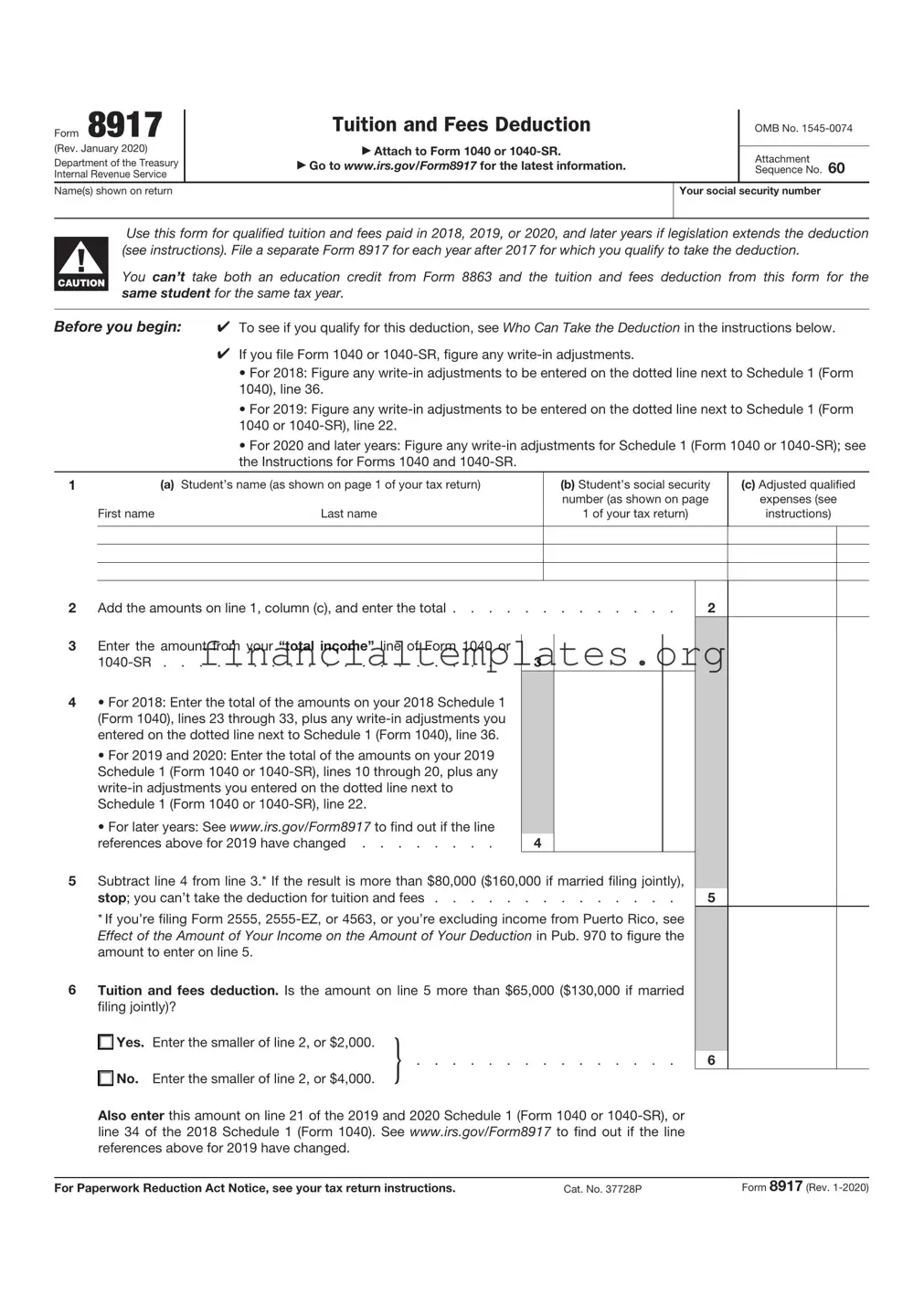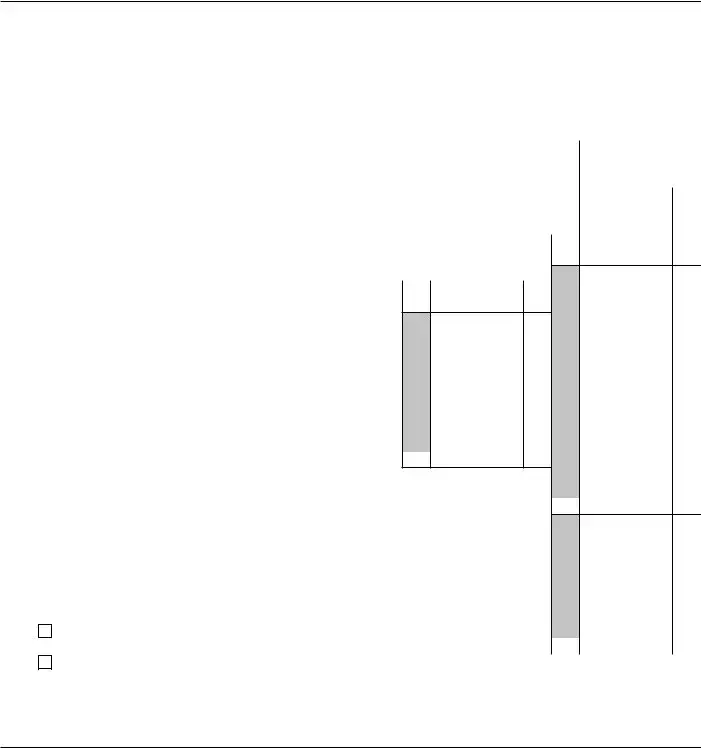General Instructions
Section references are to the Internal Revenue Code unless otherwise noted.
What’s New
Deduction extended. The tuition and fees deduction is extended for qualified tuition and fees paid in calendar years 2018, 2019, and 2020. Don’t claim the deduction for expenses paid after 2020 unless the credit is extended again. Use Form 8917 (Rev. January 2020) and these instructions for years after 2017, unless a newer revision is issued indicating it is succeeding this revision.
Periodic updating. Form 8917 will no longer be updated annually. Instead, it will only be updated when necessary. For previous years, use the applicable Form 8917 for that year.
Example 1. Use the 2017 Form 8917 for your 2017 qualified tuition and fees expenses deduction on your 2017 original or amended return.
Form 1040-SR. Form 1040-SR is a new form for 2019 and later years, with larger print and available for taxpayers 65 years or older. Although it’s often mentioned with Form 1040 on Form 8917 and in these instructions, it isn’t available for 2018.
Future Developments
For the latest information about developments related to Form 8917 and its instructions, such as legislation enacted after they were published, go to www.irs.gov/Form8917.
Reminders
Form 1098-T requirement. To be eligible to claim the tuition and fees deduction, American opportunity credit, or the lifetime earning credit, the law requires a taxpayer (or a dependent) to have received a Form 1098-T from an eligible educational institution.
However, a taxpayer may claim one of these education benefits if the student doesn’t receive a Form 1098-T because the student’s educational institution isn’t required to send a Form 1098-T to the student under existing rules (for example, if the student is a nonresident alien, has qualified education expenses paid entirely with scholarships, or has qualified education expenses paid under a formal billing arrangement). If a student’s educational institution isn’t required to provide a Form 1098-T to the student, a taxpayer may claim one of these education benefits without a Form 1098-T if the taxpayer otherwise qualifies, can demonstrate that the taxpayer (or a dependent) was enrolled at an eligible educational institution, and can substantiate the payment of qualified tuition and related expenses.
Purpose of Form
Use Form 8917 (Rev. January 2020) to figure and take the deduction for tuition and fees expenses paid in calendar years 2018, 2019, and 2020, and later years if the deduction is extended.
This deduction is based on adjusted qualified education expenses paid to an eligible educational institution (postsecondary). See Qualified Education Expenses, later, for more information.
You may be able to take the American opportunity credit TIP or lifetime learning credit for your education expenses
instead of the tuition and fees deduction. See Form 8863, Education Credits, and Pub. 970, Tax Benefits for Education, for more information about these credits.
Who Can Take the Deduction
You may be able to take the deduction if you, your spouse, or a dependent you claim on your tax return was a student enrolled at or attending an eligible educational institution. The deduction is based on the amount of qualified education expenses you paid for the student in the current year for academic periods beginning in the current year or beginning in the first 3 months of the following year.
Generally, in order to claim the deduction for education expenses for a dependent, you must have paid the expenses in the current year and must claim the student as a dependent on your current year tax return (the “Dependents” line of Form 1040 or 1040-SR). For additional information, see Pub. 970.
You can’t claim the tuition and fees deduction if any of the following apply.
•Your filing status is married filing separately.
•Another person can claim an exemption for you as a dependent on his or her tax return. You can’t take the deduction even if the other person doesn’t actually claim that exemption.
•Your modified adjusted gross income (MAGI), as figured on line 5, is more than $80,000 ($160,000 if filing a joint return).
•You were a nonresident alien for any part of the year and didn’t elect to be treated as a resident alien for tax purposes. More information on nonresident aliens can be found in Pub. 519, U.S. Tax Guide for Aliens.
You can’t claim a tuition and fees deduction for any student if you or anyone else claims an American opportunity or lifetime learning credit (Form 8863) in the current year for expenses of the student for whom the qualified education expenses were paid. However, a state tax credit won’t disqualify you from claiming a tuition and fees deduction.
Qualified Education Expenses
Generally, qualified education expenses are amounts paid in the current year for tuition and fees required for the student’s enrollment or attendance at an eligible educational institution. Required fees include amounts for books, supplies, and equipment used in a course of study if required to be paid to the institution as a condition of enrollment or attendance. It doesn’t matter whether the expenses were paid in cash, by check, by credit or debit card, or with borrowed funds.
Qualified education expenses include nonacademic fees, such as student activity fees, athletic fees, or other expenses unrelated to the academic course of instruction, only if the fee must be paid to the institution as a condition of enrollment or attendance. However, fees for personal expenses (described below) are never qualified education expenses.
Qualified education expenses don’t include amounts paid for the following.
•Personal expenses. This means room and board, insurance, medical expenses (including student health fees), transportation, and other similar personal, living, or family expenses.
•Any course or other education involving sports, games, or hobbies, or any noncredit course, unless such course or other education is part of the student’s degree program or helps the student acquire or improve job skills.
Qualified education expenses don’t include any expenses for which you take any other deduction, such as on Schedule A (Form 1040 or 1040-SR) or Schedule C (Form 1040 or 1040-SR).




